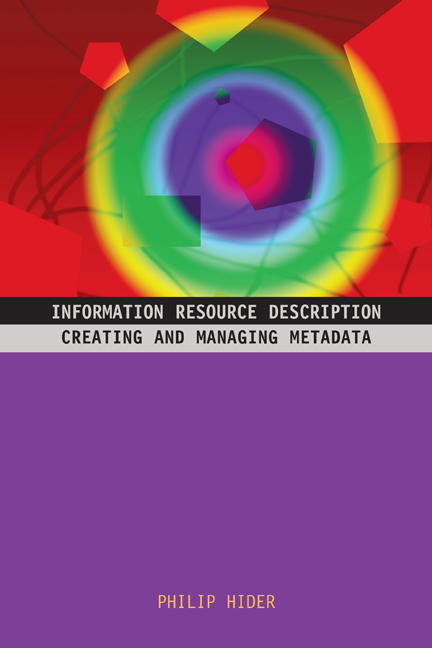Book contents
- Frontmatter
- Dedication
- Contents
- List of figures and tables
- Preface
- Abbreviations
- 1 Definitions and scope
- 2 Information resource attributes
- 3 Tools and systems
- 4 Metadata sources
- 5 Metadata quality
- 6 Sharing metadata
- 7 Metadata standards
- 8 Vocabularies
- 9 The future of metadata
- Further reading
- Metatadata standards
- Index
- Frontmatter
- Dedication
- Contents
- List of figures and tables
- Preface
- Abbreviations
- 1 Definitions and scope
- 2 Information resource attributes
- 3 Tools and systems
- 4 Metadata sources
- 5 Metadata quality
- 6 Sharing metadata
- 7 Metadata standards
- 8 Vocabularies
- 9 The future of metadata
- Further reading
- Metatadata standards
- Index
Summary
This chapter defines the book's scope and aims, and introduces key concepts that will be discussed at much greater length in the following chapters. The book's title and subtitle are explained first, and then how information resource description fits into the modern information environment. This is followed by an outline of the field of information organization and an overview of the book's structure.
Information resources
This book is about the description of information resources. Just about all types of resource can be described, and are. However, this book focuses on information resources. We are not so much interested in how vacuum cleaners, for instance, are described by sales people; we are more interested in, for example, how books (including e-books) are described by librarians. On the other hand, we are interested in how vacuum cleaners are described by museum curators: as museum objects, vacuum cleaners can provide us with information about, for instance, their mechanical development. Thus, just about everything can be an information resource, depending on the context, and so we need to avoid defining information resources too narrowly. We are interested here in the description of all resources that, in the context of their description, are primarily intended to inform.
The word ‘primarily’ in that last sentence is worth including. A very sophisticated vacuum cleaner could, say, inform its user when the dust bag is full, but, as a cleaning tool, the vacuum cleaner's primary function is to clean, not to inform. As a museum exhibit, however, its primary function would indeed be to inform. Conversely, many resources found in museums, libraries, archives and other ‘information agencies’ (they are sometimes also referred to as ‘memory institutions’) may do more than just inform, even in those contexts (they may also entertain, for instance), but a primary function is nevertheless to provide the patron with information.
Ultimately, resources are described as information resources according to the view of the describer, even if they have not been created as an information resource and are not generally used as one. However, those resources that are created primarily to inform and that are mostly used for the information they contain are those most likely to be described as information resources, and so will be given greater coverage.
- Type
- Chapter
- Information
- Information Resource DescriptionCreating and managing metadata, pp. 1 - 14Publisher: FacetPrint publication year: 2012



